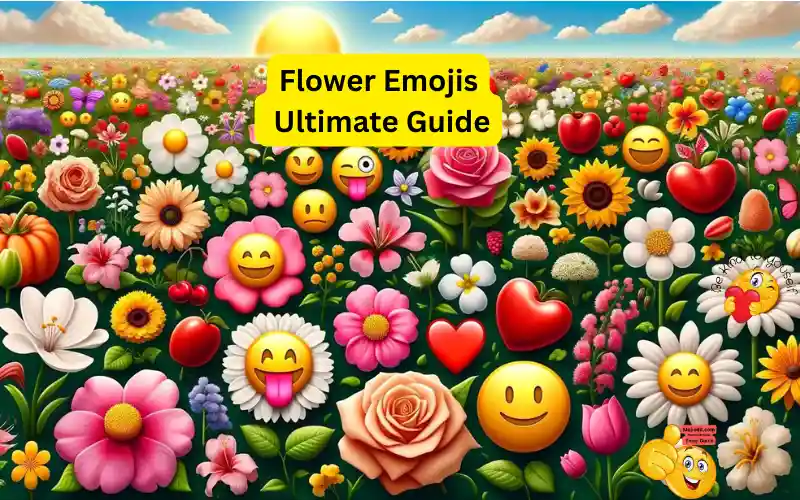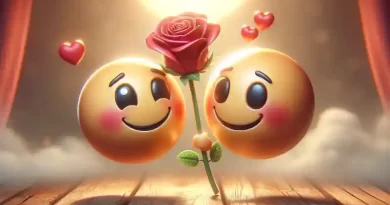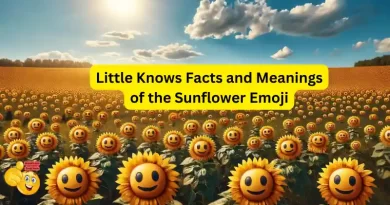10 Most Popular Flower Emojis: Guide to Hidden Meanings and Cultural Significance
🌼 The Blooming World of Flower Emojis 🌺
Welcome to the vibrant world of flower emojis! In this digital age, emojis today are a universal language, and none are more expressive than those depicting the natural beauty of flowers. From the passionate red rose to the sunny sunflower, each emoji carries a unique story and symbolism. Let’s delve into the colorful world of these emojis, uncovering their meanings, history, and cultural significance.
Overview of Flower Emojis
Flower emojis are not just digital decorations; they’re a reflection of emotions, cultural symbols, and a connection to nature. This section will explore how these emojis enhance our digital conversations, their popularity in various digital platforms, and their role in expressing emotions and sentiments.
1.🌹 The Rose Emoji: A Symbol of Passion and Romance
Symbolism & Meaning
The rose emoji 🌹 universally symbolizes love, romance, and beauty. Its deep red color evokes strong emotions, often representing heartfelt love and passion. This emjoi is perhaps one of the most popular flower emojis, especially around valentines day. Additionally, roses are widely used to convey respect, admiration, and devotion. Whether it’s Valentine’s Day, anniversaries, or just to express affection, the rose emoji is a digital gesture of love.
History & Unicode Details
- Unicode Version: Introduced in Unicode 6.0.
- Year & Codepoint: The rose emoji made its debut in 2010, designated as U+1F339.
- Example Texts: Historically, the rose emoji has been popular in romantic texts, such as “Thinking of you 🌹” or “You’re always in my heart 🌹”.
Cultural Interpretations
In different cultures, roses carry varying meanings. In Western cultures, they are often linked with romantic love, while in Eastern traditions, they can represent honor and respect. The red rose, in particular, has a deep connection with love and passion, making it a universal symbol in literature and art. It’s fascinating how this single emoji can hold such diverse meanings across the world.
2.🌸 Cherry Blossom Emoji: Echoes of Spring and Renewal
Symbolism & Meaning
The cherry blossom emoji 🌸 is a herald of spring, symbolizing renewal, the fleeting nature of life, and beauty. It’s often used to express appreciation for the transient beauty of nature and the passage of seasons. Cherry blossoms are also a popular symbol of new beginnings and hope.
History & Unicode Details
- Unicode Version: Unicode Standard Version 6.0 introduced the cherry blossom emoji.
- Year & Codepoint: It was introduced in 2010, identified by U+1F338.
- Example Texts: “Spring has arrived 🌸”, “Life is beautiful and fleeting, just like cherry blossoms 🌸”.
Cultural Interpretations
Cherry blossoms have significant cultural importance, especially in Japan where they are known as ‘Sakura.’ The Hanami festival, celebrating the bloom of cherry blossoms, is a time of joy and reflection. These flowers are not just a tourist attraction but a deep symbol of the Japanese ethos of appreciating life’s ephemeral beauty. In other cultures too, cherry blossoms are admired for their delicate beauty and are often associated with poetic themes of life and renewal.
3.💐 Bouquet Emoji: A Medley of Emotions and Celebrations
Symbolism & Meaning
The bouquet emoji 💐 is a versatile symbol representing a spectrum of emotions – from gratitude and celebration to affection and sympathy. Often used in digital communications to express thanks, celebrate special occasions, or offer comfort, this emoji encapsulates a range of positive feelings.
History & Unicode Details
- Unicode Version: Unicode 6.0 introduced the bouquet emoji.
- Year & Codepoint: It was introduced in 2010, with the codepoint U+1F490.
- Example Texts: “Thank you for your kindness 💐”, “Congratulations on your achievement! 💐”.
Cultural Interpretations
Bouquets hold different meanings in various cultures. In some, they are a traditional gift for celebrations like birthdays and weddings, symbolizing joy and happiness. In others, bouquets are used to express sympathy or condolences, offering comfort in times of sorrow. The diversity in floral arrangements within the bouquet emoji also reflects the wide range of emotions and occasions it represents, making it a universally appreciated symbol in digital communication.
4.🌷 Tulip Emoji: A Canvas of Deep Meanings and Historical Roots
Symbolism & Meaning
The tulip emoji 🌷, with its vibrant colors and elegant shape, holds a bouquet of meanings. Symbolizing perfect love, affection, and springtime beauty, it’s often used in messages that convey deep, heartfelt emotions. The tulip’s variety of colors in the emoji world further expands its range of meanings – red tulips for true love, yellow for cheerful thoughts, and white for forgiveness.
History & Unicode Details
- Unicode Version: Unicode 6.0 introduced the tulip emoji.
- Year & Codepoint: It made its way into the digital world in 2010, represented by U+1F337.
- Example Texts: “Feeling the beauty of spring with these tulips 🌷”, “Sending you love and affection 🌷”.
Cultural Interpretations
The tulip has a rich historical and cultural background. Most famously, it sparked ‘Tulip Mania’ in the Netherlands during the 17th century, becoming a symbol of wealth and status. In Turkish culture, it represents paradise on earth and has been a significant motif in Turkish art. The tulip’s symbolism varies globally – from representing love and affection in many cultures to being a token of prosperity and indulgence in others.
Tulips in Art and Literature
Tulips have been a muse in art and literature for centuries. They often appear in classical paintings, symbolizing brevity of life and the beauty of nature. In literature, tulips are metaphors for love, transformation, and even political power. Their enigmatic beauty inspires artists and writers, making them a timeless subject in creative realms.
5. 🌺 Hibiscus Emoji: A Symbol of Exotic Beauty and Warmth
Symbolism & Meaning
The hibiscus emoji 🌺, with its vibrant red petals, is often associated with exotic beauty, warm climates, and summer vibes. It is frequently used to convey feelings of happiness and carefree joy, often in messages related to vacations, warm weather, or just to add a tropical flair.
History & Unicode Details
- Unicode Version: Unicode 6.0 introduced the hibiscus emoji.
- Year & Codepoint: It blossomed in the emoji world in 2010, with the codepoint U+1F33A.
- Example Texts: “Dreaming of tropical beaches 🌺”, “Can’t wait for summer to come back 🌺”.
Cultural Interpretations
In various cultures, the hibiscus flower holds different meanings. In Hawaii, it is a symbol of hospitality and tourism, often used in traditional garlands known as leis. The hibiscus in East Asian cultures is seen as a symbol of fame, riches, and personal glory. In other parts of the world, it’s a common emblem of warmth, welcoming environments, and relaxed lifestyles.
Hibiscus in Folklore and Mythology
The hibiscus flower is not just a pretty face; it’s steeped in folklore and mythology. In Hawaiian legend, the hibiscus is often associated with the goddess of hula, Laka, symbolizing power and respect. In other myths, it’s seen as a sign of immortality or used in ceremonies as a symbol of respect and honor.
The Hibiscus in Modern Culture
Today, the hibiscus emoji is more than just a digital flower; it’s a symbol of relaxation and vacation. It evokes a sense of escape to tropical paradises. The emoji has also found its way into fashion, where it adorns clothing and accessories as a symbol of laid-back, summery vibes.
6. 🥀 Wilted Flower Emoji: A Symbol of Fading Beauty and Lost Love
Symbolism & Meaning
The wilted flower emoji 🥀 represents more than just a dying bloom; it symbolizes lost love, disappointment, or the end of something once beautiful. Often used in messages to convey sadness, regret, or a sense of something fleeting, it captures the essence of impermanence in relationships and beauty.
History & Unicode Details
- Unicode Version: Unicode 9.0 introduced the wilted flower emoji.
- Year & Codepoint: It found its place in our emoji vocabulary in 2016, with the codepoint U+1F940.
- Example Texts: “Feeling a bit down today 🥀”, “Missing the good old days 🥀”.
Cultural Interpretations
In many cultures, a wilted flower, especially a rose, is seen as a symbol of things that have passed or lost their vibrancy. It’s often found in art and literature, representing the transient nature of life and love, and the sadness of things that wither away.
Wilted Flowers in Poetry and Art
Throughout history, wilted flowers have been a recurring theme in poetry and art, symbolizing the ephemeral nature of beauty and life. Poets and artists often use wilted flowers to represent a lost love or a sense of melancholy, encapsulating the beauty even in decay.
The Wilted Flower in Contemporary Expression
In modern times, the wilted flower emoji expresses feelings of nostalgia, sadness, or even ironic detachment. It’s a digital representation of the universal experience of loss and the bittersweet nature of memories.
7. 🌻 Sunflower Emoji: A Beacon of Joy and Strength
Symbolism & Meaning
The sunflower emoji 🌻 embodies happiness, adoration, and unwavering loyalty. It is one of the most popular flower emojis. With its face turned towards the sun, it symbolizes optimism and longevity. This emoji can brighten up someone’s day and represents a sunny disposition, or shows admiration.
History & Unicode Details
- Unicode Version: Unicode 6.0 introduced the sunflower emoji.
- Year & Codepoint: Added in 2010 and identified by the pointcode U+1F33B.
- Example Texts: “You are my sunshine 🌻”, “Keep looking towards the light 🌻”.
Cultural Interpretations
In various cultures, sunflowers have been symbols of the sun and its life-giving energy. They are often associated with happiness, vitality, and spiritual growth. In Native American cultures, sunflowers are seen as symbols of harvest and provision.
Sunflowers in Mythology and Literature
Sunflowers have a storied presence in mythology and literature. Symbolizes unrequited love and loyalty in Greek mythology, the sunflower is tied to the story of Clytie and Apollo. In literature, sunflowers poets and writers use it to represent a yearning for light and truth.
The Sunflower’s Role in Environmental Awareness
Beyond their symbolic meanings, sunflowers play a significant role in environmental awareness. They are known for their ability to clean contaminated soil and used in projects to absorb toxins and improve environmental health.
8. 🌼 Blossom Emoji: Symbol of Delicate Beauty and Renewal
Symbolism & Meaning
The blossom emoji 🌼 represents the gentle beauty and renewal of nature. Often associated with spring, it conveys happiness, new beginnings, and simple joys. This emoji spreads positivity, celebrates the changing seasons, and shares the beauty of nature.
History & Unicode Details
- Unicode Version: Introduced in Unicode 6.0.
- Year & Codepoint: The blossom emoji made its debut in 2010, with the codepoint U+1F33C.
- Example Texts: “Embracing the new beginnings of spring 🌼”, “Finding joy in the little things 🌼”.
Cultural Interpretations
In many cultures, blossoms symbolize purity, rebirth, and the transient nature of life. They are celebrated in festivals, such as the Cherry Blossom Festival in Japan, and are often used in art and poetry to symbolize fleeting beauty.
Blossoms in Folklore and Symbolism
Blossoms have a rich presence in folklore across the world. In some stories, they represent the cycle of life and renewal, while in others, they are symbols of luck and prosperity. Their delicate and ephemeral nature often leads them to be metaphors for the transient yet beautiful moments in life.
The Blossom Emoji in Modern Digital Communication
In the realm of digital communication, the blossom emoji is a favorite for conveying a sense of lightness and joy. Its use in social media posts, texts, and digital art adds a touch of springtime charm symbolizes hope and optimism.
9. 🏵️ Rosette Emoji: Emblem of Honor and Recognition
Symbolism & Meaning
The rosette emoji 🏵️ is rich in symbolism, representing honor, achievement, and recognition. In digital communication, it acknowledges accomplishments, celebrates victories, and confers respect and admiration.
History & Unicode Details
- Unicode Version: Unicode 7.0 introduced the rosette emoji.
- Year & Codepoint: It made its entry in 2014, with the codepoint U+1F3F5.
- Example Texts: “Congrats on your achievement 🏵️”, “Honoring your dedication and hard work 🏵️”.
Cultural Interpretations
In various cultures, rosettes are symbols of excellence and distinction. Traditionally, they are used as awards in competitions and as badges of honor in military and academic circles.
Rosettes in Ceremonial and Decorative Uses
The use of rosettes spans from ceremonial to decorative purposes. Historically they are used in military ceremonies to denote rank and achievement, and in civilian life as ornamental badges for distinguished service or achievement.
The Rosette Emoji in Social Recognition
In the digital age, the rosette emoji has found its place in social media and online communities as a way to recognize and celebrate personal and professional achievements. Its use in congratulatory messages and posts adds a touch of prestige and honor, acknowledging accomplishments in a visually appealing way.
10.💮 White Flower: A Symbol of Purity and Perfection
Conclusion
As we conclude our journey through the garden of flower emojis, we see how these tiny digital symbols enrich our communication. They bring a piece of nature’s beauty into our everyday interactions, allowing us to express complex emotions and cultural identities with a single tap. In the dynamic world of digital communication, flower emojis stand out as a testament to our enduring love for the natural world and its symbolism.
FAQ
Flower emojis symbolize various emotions and messages. For example, a rose emoji 🌹 symbolizes love and romance, while a sunflower emoji 🌻 represents joy and positivity.
Yes, flower emojis can have varied interpretations across cultures. For instance, in East Asian cultures, the white flower emoji 💮 often represents purity and is used in ceremonies, while in Western contexts, it symbolizes innocence and new beginnings.
The wilted flower emoji symbolizes sadness, grief, or the end of something once beautiful, like a relationship or a joyous phase. It’s often used to convey feelings of loss or melancholy.
The bouquet emoji can be used to symbolize congratulations, celebration, or appreciation. It’s a versatile emoji suitable for various occasions, from birthdays to expressing gratitude.
The cherry blossom emoji is often used to represent springtime, new beginnings, and renewal. It’s also associated with femininity, happiness, and positivity.






